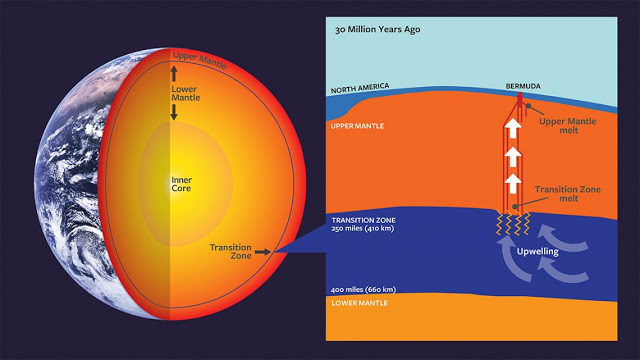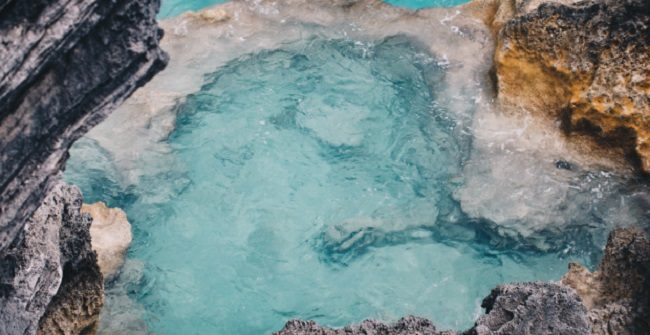Over 30 million years ago, the island of Bermuda would have looked a bit different-where sunburnt tourists now sit sipping piña coladas, there may have been a hot, coursing river of lava. No humans were harmed during this volcanic episode, although that's mainly because humans did not exist yet (existing animals may not have been so lucky). While little evidence of this is exposed on the island's limestone surface, scientists can drill below to access Bermuda's deep volcanic history.
Back in the 70s, geologists from Dalhousie University and the Lamont-Doherty Earth Observatory drilled a hole into the Bermuda platform over 2,600 feet deep, extracting tons of cylindrical volcanic rock samples. A few studies looked at these rocks, but since then, the core has been mostly collecting dust in a basement in Halifax, waiting for someone to stumble across it again.
Decades later, Sarah Mazza, a volcanologist at the University of Münster, noticed something peculiar while looking at these rocks under a microscope.
"I first suspected that Bermuda's volcanic past was special as I sampled the core and noticed the diverse textures and mineralogy preserved in the different lava flows," said Mazza.
Bermuda Triangle? More like Ber-magma Triangle
While most people picture the mantle as a coursing soup of hot, liquid magma, this isn't really the case. Sure the earth's interior is incredibly hot, but it also has the pressure of millions of pounds of rock above it, which keeps the mantle in a mostly solid state. Magma itself is rare, and some even argue that liquid, eruptible magma can only exist for a short time - we're talking decades, to years, to even days. In the rare places where conditions are just right, that's where we find magmas, and importantly, volcanoes.
"We were expecting our data to show the volcano was a mantle plume formation - an upwelling from the deeper mantle - just like it is in Hawaii," said co-author Esteban Gazel. What they found, however, was something completely different.
In Hawaii and many other volcanic islands, magma comes from molten rock forming deep at the boundary between the mantle and the core. Islands like this usually form in long chains, as tectonic plates move above the mantle plume. If you were flying over Bermuda though, you wouldn't see a chain, you'd just see one singular landmass in the ocean; and to geologists, this just didn't make sense.
Intrigued by the island and its puzzling rocks, the researchers analyzed the core in a lab. Working like detectives, geologists can use the geochemistry of the rocks as evidence to trace where a magma comes from. Then, they can calculate all sorts of things, like how hot the magma was, what kinds of gases it contained, and even when it erupted.
"There is a lot of different findings in this paper," said Mazza, "and they all piece together to tell a story of a different type of volcanic process, one that hasn't necessarily been recorded before."
Their calculations showed the magma was too cold to be from the deep mantle like Hawaiian volcanoes but too hot to be from other volcanoes. Volcanic gases in the rocks showed volatile budgets way too high to have originated in the mantle as well. On top of that, their rocks have some of the highest lead isotope concentrations ever seen in an oceanic volcano. Weirder still, they found there were, in fact, two conflicting signals-one with incredibly high lead, the other with low lead. To produce both signatures, the source of this magma had to be a lot younger than expected.
To understand these quirky chemistries, the geologists looked at the problem from another perspective. Using geophysics to model the earth's past heat fluxes, scientists identified a thermal anomaly in the mantle about 250 miles below the surface, in an area called the transition zone.

If correct, this would be the first study to show magmas form in the transition zone, meaning this volcano, is unlike any in the world. Not only that, but it would also change scientists perception of how long it takes rocks to cycle through the mantle. Previously, scientists thought that material in the mantle cycled over the course of hundreds of millions of years, but these lava samples suggest otherwise.
So, why did Bermuda host this odd volcano? Scientists have traced this strange magma reservoir back to the supercontinent Pangea, suggesting it formed either when the landmasses were coming together, or when they were breaking apart. See, in both scenarios, the mantle would become rich in fluids and carbon, which would change the types of minerals that form and the temperatures at which they form, creating a rare opportunity to form magma in the transition zone.
"The data by itself is really interesting," said Katherine Kelley, a volcanologist at the University of Rhode Island, "because we have a record of a magma that's never been documented at the earth's surface before. It's really rare to find a new rock, but this one is totally new."
It's likely that this kind of volcano is endemic to the Atlantic ocean, but it may not be the only one in the world. Remote seamounts in the region may share compositional similarities to one's from Bermuda.
"There's a lot of what I like to call "volcanic pimples" covering the Atlantic Ocean floor around and north of Bermuda," said Mazza, "If we were to look around, we might see more evidence of this volcanic reservoir there".




I have considered that the 'drowned coastlines' of the world, the 200 feet where the oceans crept inland to make flooded coasts, are actually recent and may have been created when the theorized large land masses of Lemuria sank.
I hope to actually see a theory as to why Lemuria sank and Greenland did not. Science has looked at the imaginary black holes to see ours does not grow, the gases actually circle the highly pressurized area. Perhaps these highly pressurized areas exist as a smaller version of spirals that attach themselves to a specific area of the Earth's crust; perhaps they are produced not externally by solar weather but internally from the Earth's core as recycled energy from strongly localized photon or electron emitters.